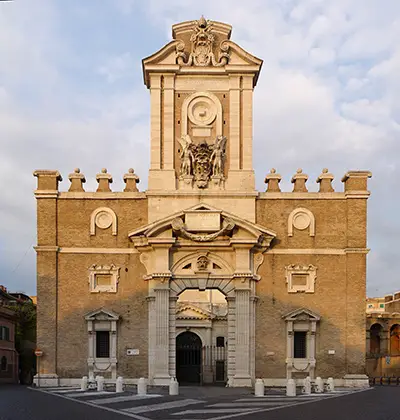The gate was designed by Michelangelo and is located at the end of the Via Pia, a new street, and was a replacement of the Porta Nomentana which was situated several hundred meters on the south, and closed at the same time.
The construction of Porta Pia commenced in 1551 and ended after Michelangelo’s death in 1956. Gianfederico Bonzagna’s commemorative bronze medal of 1561 exhibits Michelangelo’s initial plan, which was very distinct from his final design. After his death, under Virginio Vespignani’s Nep-Classicist design, the facade of the exterior of the city was completed in 1869.
There were various reasons for the construction of the Porta Pia. The main motive, however, was that there was the need of a replacement for the new urban area, which the ancient Porta Nomentana for the Via Nomentana access could not provide.
Michelangelo was a renowned designer and a friend of the Pope. According to Vasari, the Pope requested for designs that would be used in the construction Porta Pia. Michelangelo handed over three designs to him, which were beautifully and precisely done. However, they all differed in their appearance and extravagance, and the Pope went for the simplest and cheapest looking plan that would see the construction of the current Porta Pia. The choice made by the Pope could be credited to details that were hard for him to comprehend on the other two designs.
There is, however, no evidence that the design was carried out exactly as it appeared on the design that the Pope chose as there are no traces that exist of the three drawings, except certain details of the sketches.
There were several changes made on the appearance of the gate as depicted on the 1561 commemorative coin and on a 1568 engraving which is the only epoch’s documentation. The current appearance of the gate is quite different from its early portrayal on the coin and engraving.
Forty years after the gate was constructed, it appeared on maps of Rome as almost ruin-like. The design portrayed on the coin could be close to that of the initial plan. However, there are two factors that could have altered the initial design.
The Pope needed a simple design, and this would have led to changes in the appearance of the gate, and the death of Michelangelo before the construction work was completed. Giacomo Del Duca, who also built Porta San Giovanni, took over the work after his death and this could have contributed to the change in the initial design.
According to various researchers, Michelangelo’s initial idea was to create picturesque and dramatic facades that would be symbolic to Rome’s functions of the entrance. More emphasis on the gate is made through the positioning of the portal which is located at the end of Strada Pia, resuming the ancient Alta Semita’s route.
It then makes a continuation through XX Settembre and ends on a frontal prospect at the beginning of the Quirinal. The gate was set strategically slightly behind the wall lines, which interlinked the two lateral oblique sections of the wall, had only one arch as it appears on the coin and overhung by the gate’s wall-ends with the reverse facing the city.
The outside appeared only as a simple fornix. Around 1575, a second arch was opened as an effect of an increase in traffic, which resulted due to the closure of the nearby porta Nomentana.
There is a tower on the outside of the gate, as depicted on the prints and engravings up to 1577. It is, however, doubtful whether this was lost as a result of a reduction in the design complexity or collapse. The external facades were completed in 1869 by Virginio Vespignani, who seemed to have been inspired by a 1568 engraving to follow the original plan by Michelangelo very closely.
Following a lightning damage in 1851, the 1853 restoration work incorporated a new courtyard and buildings. In accordance with the will of Pius IX, the new facade houses two statues of saints Alexander and Agnes, in keeping with the city walls, bordered by four columns. After Pope’s escape from danger during the Sant’Agnese’s convent audience chamber collapse, during his April 12, 1955, visit there, he needed a memorial. An inscription recording his escape was done on the external side, above the arch.
Despite the fact that Michelangelo dies before completing the construction of Porta Pia, his contribution to the current design cannot be overlooked. Although various designers took over after his demise, there are only a few notable changes that were made from his initial design, and this makes him take much of the credit in the construction of Porta Pia.


